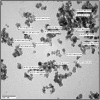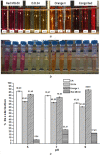Immobilisation of bacteria onto magnetic nanoparticles for the decolorisation and degradation of azo dyes
- PMID: 31051444
- PMCID: PMC8676242
- DOI: 10.1049/iet-nbt.2018.5026
Immobilisation of bacteria onto magnetic nanoparticles for the decolorisation and degradation of azo dyes
Abstract
Azo dyes are widely used in industries and their release in the environment contributes to the pollution of effluents. The authors aim to develop a new eco-friendly water treatment method for the degradation of azo dyes based on in situ magnetic separation and immobilisation of bacterial cells. The immobilisation was achieved using superparamagnetic Fe3O4 nanoparticles and offers the possibility of reusing bacteria by magnetic separation for several degradation cycles. The iron-oxide nanoparticles were synthesised by reverse co-precipitation. The Gram-positive bacteria Bacillus subtilis were immobilised using iron-oxide nanoparticles by adsorption and then separated with an external magnetic field. Transmission electron microscopy observation showed that the particles' diameter was ∼20 nm with a narrow size distribution. Moreover, the iron-oxide nanoparticles were adsorbed onto the surface in order to coat the cells. B. subtilis has proved its ability to decolorise and degrade several azo dyes at different values of pH, with the highest decolorisation rate for Congo red. Furthermore, immobilised cells have a degradation activity similar to that of free cells. The system provided a degradation rate up to 80% and could be reused for seven batch cycles.
Figures














Similar articles
-
Adsorption studies of cationic, anionic and azo-dyes via monodispersed Fe3O4 nanoparticles.J Nanosci Nanotechnol. 2013 May;13(5):3240-5. doi: 10.1166/jnn.2013.7152. J Nanosci Nanotechnol. 2013. PMID: 23858837
-
Mixed azo dyes degradation by an intracellular azoreductase enzyme from alkaliphilic Bacillus subtilis: a molecular docking study.Arch Microbiol. 2021 Aug;203(6):3033-3044. doi: 10.1007/s00203-021-02299-2. Epub 2021 Mar 29. Arch Microbiol. 2021. PMID: 33782718
-
Citric Acid Fuctionalized Magnetic Ferrite Nanoparticles for Photocatalytic Degradation of Azo Dye.J Nanosci Nanotechnol. 2015 Jan;15(1):273-80. doi: 10.1166/jnn.2015.9223. J Nanosci Nanotechnol. 2015. PMID: 26328345
-
Magnetic immobilization of bacteria using iron oxide nanoparticles.Biotechnol Lett. 2018 Feb;40(2):237-248. doi: 10.1007/s10529-017-2477-0. Epub 2017 Nov 27. Biotechnol Lett. 2018. PMID: 29181762 Review.
-
Removal of water contaminants by iron oxide nanomaterials.J Nanosci Nanotechnol. 2014 Jan;14(1):627-43. doi: 10.1166/jnn.2014.9053. J Nanosci Nanotechnol. 2014. PMID: 24730287 Review.
Cited by
-
Tailoring Vanadium-Based Magnetic Catalyst by In Situ Encapsulation of Tungsten Disulfide and Applications in Abatement of Multiple Pollutants.ACS Omega. 2023 Dec 12;8(51):48966-48974. doi: 10.1021/acsomega.3c06580. eCollection 2023 Dec 26. ACS Omega. 2023. PMID: 38162758 Free PMC article.
-
Adaptation of the binding domain of Lactobacillus acidophilus S-layer protein as a molecular tag for affinity chromatography development.Front Microbiol. 2023 Jun 13;14:1210898. doi: 10.3389/fmicb.2023.1210898. eCollection 2023. Front Microbiol. 2023. PMID: 37383629 Free PMC article.
-
Bacillus subtilis: As an Efficient Bacterial Strain for the Reclamation of Water Loaded with Textile Azo Dye, Orange II.Int J Mol Sci. 2022 Sep 13;23(18):10637. doi: 10.3390/ijms231810637. Int J Mol Sci. 2022. PMID: 36142543 Free PMC article.
-
Characterization of Immobilized Magnetic Fe3O4 Nanoparticles on Raoultella Ornithinolytica sp. and Its Application for Azo Dye Removal.Appl Biochem Biotechnol. 2022 Dec;194(12):6068-6090. doi: 10.1007/s12010-022-04076-3. Epub 2022 Jul 26. Appl Biochem Biotechnol. 2022. PMID: 35881226 Free PMC article.
-
Development and assessment of an immobilized bacterial alliance that efficiently degrades tylosin in wastewater.PLoS One. 2024 May 31;19(5):e0304113. doi: 10.1371/journal.pone.0304113. eCollection 2024. PLoS One. 2024. PMID: 38820335 Free PMC article.
References
-
- Pandey A. Singh P. Iyengar L.: ‘Bacterial decolorization and degradation of azo dyes’, Int. Biodeterior. Biodegrad., 2007, 59, (2), pp. 73 –84
-
- Hao O.J. Kim H. Chiang P.‐C.: ‘Decolorization of wastewater’, Crit. Rev. Environ. Sci. Technol., 2000, 30, (4), pp. 449 –505
-
- Gupta V.: ‘Application of low‐cost adsorbents for dye removal–a review’, J. Environ. Manag., 2009, 90, (8), pp. 2313 –2342 - PubMed
-
- Saratale R.G. Saratale G.D. Chang et al.: ‘Bacterial decolorization and degradation of azo dyes: a review’, J. Taiwan Inst. Chem. Eng., 2011, 42, (1), pp. 138 –157
-
- Vandevivere P.C. Bianchi R. Verstraete W.: ‘Treatment and reuse of wastewater from the textile wet‐processing industry: review of emerging technologies’, J. Chem. Technol. Biotechnol., 1998, 72, (4), pp. 289 –302
MeSH terms
Substances
LinkOut - more resources
Full Text Sources

